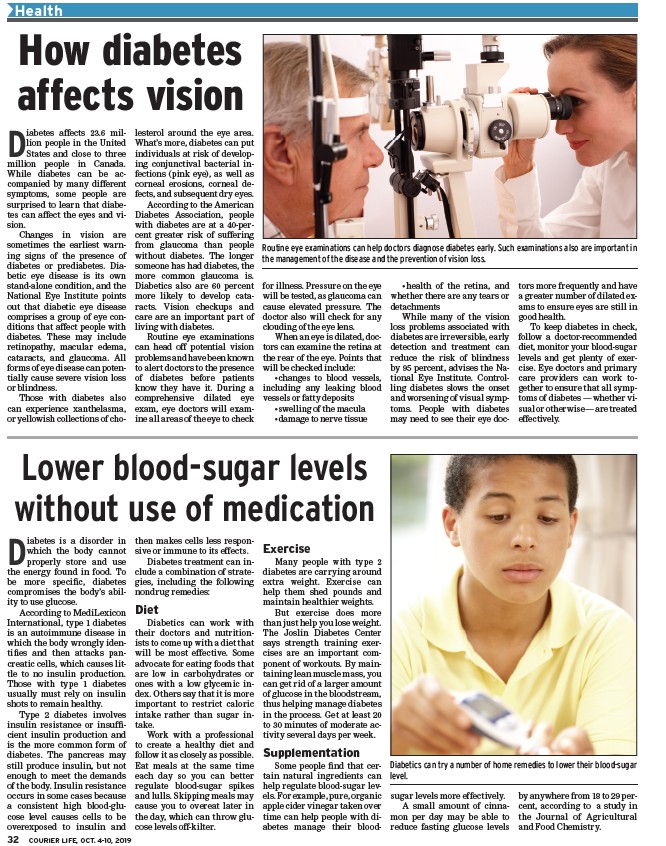
Diabetes affects 23.6 million
people in the United
States and close to three
million people in Canada.
While diabetes can be accompanied
by many different
symptoms, some people are
surprised to learn that diabetes
can affect the eyes and vision.
Changes in vision are
sometimes the earliest warning
signs of the presence of
diabetes or prediabetes. Diabetic
eye disease is its own
stand-alone condition, and the
National Eye Institute points
out that diabetic eye disease
comprises a group of eye conditions
that affect people with
diabetes. These may include
retinopathy, macular edema,
cataracts, and glaucoma. All
forms of eye disease can potentially
cause severe vision loss
or blindness.
Those with diabetes also
can experience xanthelasma,
or yellowish collections of cholesterol
COURIER L 32 IFE, OCT. 4-10, 2019
around the eye area.
What’s more, diabetes can put
individuals at risk of developing
conjunctival bacterial infections
(pink eye), as well as
corneal erosions, corneal defects,
and subsequent dry eyes.
According to the American
Diabetes Association, people
with diabetes are at a 40-percent
greater risk of suffering
from glaucoma than people
without diabetes. The longer
someone has had diabetes, the
more common glaucoma is.
Diabetics also are 60 percent
more likely to develop cataracts.
Vision checkups and
care are an important part of
living with diabetes.
Routine eye examinations
can head off potential vision
problems and have been known
to alert doctors to the presence
of diabetes before patients
know they have it. During a
comprehensive dilated eye
exam, eye doctors will examine
all areas of the eye to check
Routine eye examinations can help doctors diagnose diabetes early. Such examinations also are important in
the management of the disease and the prevention of vision loss.
for illness. Pressure on the eye
will be tested, as glaucoma can
cause elevated pressure. The
doctor also will check for any
clouding of the eye lens.
When an eye is dilated, doctors
can examine the retina at
the rear of the eye. Points that
will be checked include:
• changes to blood vessels,
including any leaking blood
vessels or fatty deposits
• swelling of the macula
• damage to nerve tissue
• health of the retina, and
whether there are any tears or
detachments
While many of the vision
loss problems associated with
diabetes are irreversible, early
detection and treatment can
reduce the risk of blindness
by 95 percent, advises the National
Eye Institute. Controlling
diabetes slows the onset
and worsening of visual symptoms.
People with diabetes
may need to see their eye doctors
more frequently and have
a greater number of dilated exams
to ensure eyes are still in
good health.
To keep diabetes in check,
follow a doctor-recommended
diet, monitor your blood-sugar
levels and get plenty of exercise.
Eye doctors and primary
care providers can work together
to ensure that all symptoms
of diabetes — whether visual
or otherwise — are treated
effectively.
Diabetes is a disorder in
which the body cannot
properly store and use
the energy found in food. To
be more specifi c, diabetes
compromises the body’s ability
to use glucose.
According to MediLexicon
International, type 1 diabetes
is an autoimmune disease in
which the body wrongly identifi
es and then attacks pancreatic
cells, which causes little
to no insulin production.
Those with type 1 diabetes
usually must rely on insulin
shots to remain healthy.
Type 2 diabetes involves
insulin resistance or insuffi -
cient insulin production and
is the more common form of
diabetes. The pancreas may
still produce insulin, but not
enough to meet the demands
of the body. Insulin resistance
occurs in some cases because
a consistent high blood-glucose
level causes cells to be
overexposed to insulin and
then makes cells less responsive
or immune to its effects.
Diabetes treatment can include
a combination of strategies,
including the following
nondrug remedies:
Diet
Diabetics can work with
their doctors and nutritionists
to come up with a diet that
will be most effective. Some
advocate for eating foods that
are low in carbohydrates or
ones with a low glycemic index.
Others say that it is more
important to restrict caloric
intake rather than sugar intake.
Work with a professional
to create a healthy diet and
follow it as closely as possible.
Eat meals at the same time
each day so you can better
regulate blood-sugar spikes
and lulls. Skipping meals may
cause you to overeat later in
the day, which can throw glucose
levels off-kilter.
Exercise
Many people with type 2
diabetes are carrying around
extra weight. Exercise can
help them shed pounds and
maintain healthier weights.
But exercise does more
than just help you lose weight.
The Joslin Diabetes Center
says strength training exercises
are an important component
of workouts. By maintaining
lean muscle mass, you
can get rid of a larger amount
of glucose in the bloodstream,
thus helping manage diabetes
in the process. Get at least 20
to 30 minutes of moderate activity
several days per week.
Supplementation
Some people fi nd that certain
natural ingredients can
help regulate blood-sugar levels.
For example, pure, organic
apple cider vinegar taken over
time can help people with diabetes
manage their bloodsugar
levels more effectively.
A small amount of cinnamon
per day may be able to
reduce fasting glucose levels
by anywhere from 18 to 29 percent,
according to a study in
the Journal of Agricultural
and Food Chemistry.
How diabetes
affects vision
Lower blood-sugar levels
without use of medication
Diabetics can try a number of home remedies to lower their blood-sugar
level.
Health